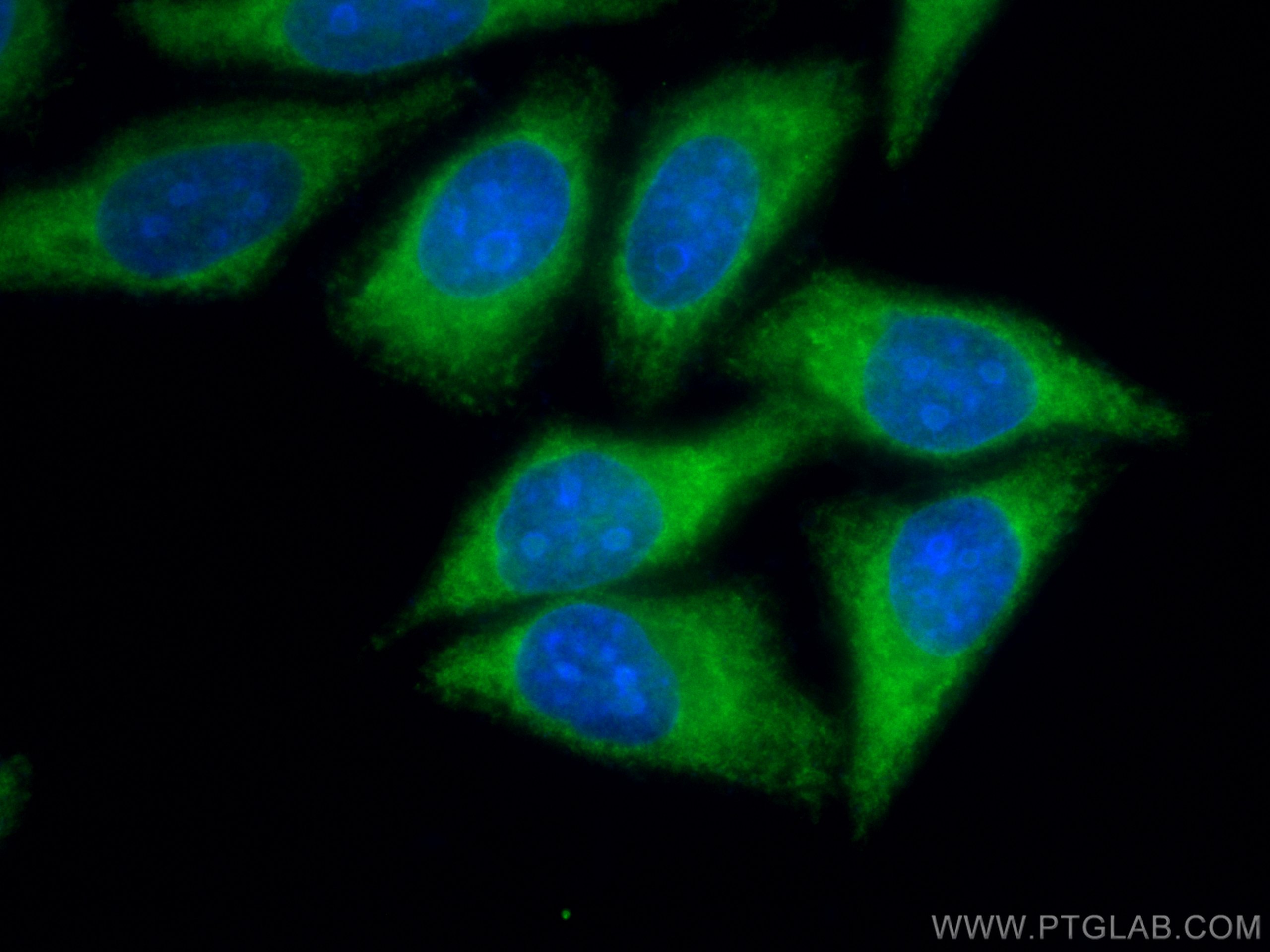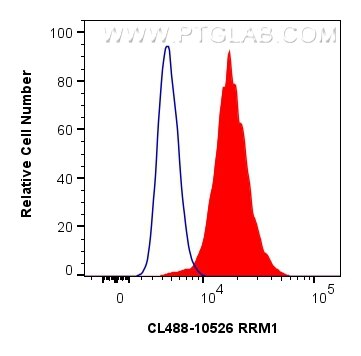- Featured Product
- KD/KO Validated
RRM1 Polyklonaler Antikörper
RRM1 Polyklonal Antikörper für IF/ICC, FC (Intra)
Wirt / Isotyp
Kaninchen / IgG
Getestete Reaktivität
Affe, human, Maus, Ratte
Anwendung
IF/ICC, FC (Intra)
Konjugation
CoraLite® Plus 488 Fluorescent Dye
Kat-Nr. : CL488-10526
Synonyme
Geprüfte Anwendungen
| Erfolgreiche Detektion in IF/ICC | HepG2-Zellen |
| Erfolgreiche Detektion in FC (Intra) | HeLa-Zellen |
Empfohlene Verdünnung
| Anwendung | Verdünnung |
|---|---|
| Immunfluoreszenz (IF)/ICC | IF/ICC : 1:50-1:500 |
| Durchflusszytometrie (FC) (INTRA) | FC (INTRA) : 0.40 ug per 10^6 cells in a 100 µl suspension |
| It is recommended that this reagent should be titrated in each testing system to obtain optimal results. | |
| Sample-dependent, check data in validation data gallery | |
Produktinformation
CL488-10526 bindet in IF/ICC, FC (Intra) RRM1 und zeigt Reaktivität mit Affe, human, Maus, Ratten
| Getestete Reaktivität | Affe, human, Maus, Ratte |
| Wirt / Isotyp | Kaninchen / IgG |
| Klonalität | Polyklonal |
| Typ | Antikörper |
| Immunogen | RRM1 fusion protein Ag0789 |
| Vollständiger Name | ribonucleotide reductase M1 |
| Berechnetes Molekulargewicht | 90 kDa |
| Beobachtetes Molekulargewicht | 90 kDa |
| GenBank-Zugangsnummer | BC006498 |
| Gene symbol | RRM1 |
| Gene ID (NCBI) | 6240 |
| Konjugation | CoraLite® Plus 488 Fluorescent Dye |
| Excitation/Emission maxima wavelengths | 493 nm / 522 nm |
| Form | Liquid |
| Reinigungsmethode | Antigen-affinitätsgereinigt |
| Lagerungspuffer | PBS with 50% glycerol, 0.05% Proclin300, 0.5% BSA |
| Lagerungsbedingungen | Bei -20°C lagern. Vor Licht schützen. Nach dem Versand ein Jahr stabil. Aliquotieren ist bei -20oC Lagerung nicht notwendig. 20ul Größen enthalten 0,1% BSA. |
Hintergrundinformationen
Ribonucleoside-diphosphate reductase large subunit (RRM1) is the main enzyme for de novo deoxyribonucleotide
synthesis necessary for DNA synthesis during the cell cycle as well as during DNA repair.
What is the molecular weight of RRM1?
The molecular weight of RRM1 is 90 kDa. RRM1 is a part of ribonucleotide reductase (RNR), which is composed
of two large RRM1 and two small RRM2 subunits in S phase and two large RRM1 and two alternative small p53R2
subunits in non-dividing quiescent cells (PMID: 17416930).
What is the subcellular localization of RRM1?
RRM1 localizes to the cytoplasm, where it is responsible for dNTP production, forming a complex with RRM2.
However, RRM1 can be recruited to DNA damage sites in the nucleus via interaction with Tip60 (PMID: 20159953).
What is the tissue expression pattern of RRM1?
RRM1 is ubiquitously expressed.
How is RRM1 expression regulated during the cell cycle and upon DNA damage?
Rrm1 gene expression levels depend on the cell cycle, and the highest mRNA levels are observed in S phase.
However, RRM1 protein levels are constant throughout the cell cycle due to long protein half-life, contrary to
RRM2, which is actively degraded after cell exit from S phase. During DNA damage, e.g., induced with genotoxins
or UV light, expression of RRM1 and RRM2/p53R2 is upregulated (PMID: 1551913 and 8798592).
Protokolle
| PRODUKTSPEZIFISCHE PROTOKOLLE | |
|---|---|
| IF protocol for CL Plus 488 RRM1 antibody CL488-10526 | Protokoll herunterladen |
| FC protocol for CL Plus 488 RRM1 antibody CL488-10526 | Download protocol |
| STANDARD-PROTOKOLLE | |
|---|---|
| Klicken Sie hier, um unsere Standardprotokolle anzuzeigen |



